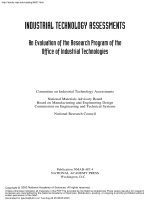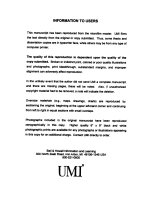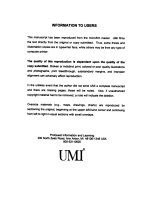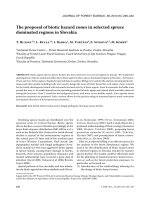Research proposal of Tesol 2018
Bạn đang xem bản rút gọn của tài liệu. Xem và tải ngay bản đầy đủ của tài liệu tại đây (80.16 KB, 11 trang )
Providing American cultural knowledge for student
of Business English major based on opposite values of
Geert Hofdtede
INTRODUCTION
1. Background and the statement of problem
Communication in general and intercultural communication are rooted in
culture and society and seem to withstand the change of time. Consequently, cultural
understanding and learning increasingly plays an important role in the global village
where we live. Understanding the most intimate relationship between culture and
communication is intercultural communication that helps us succeed in a multicultural
and multi-dimensional world.
English is used in almost aspect of life. Therefore, teaching English in the age
of globalization does not merely teach language skills such as vocabulary, sentence
structure and grammar or listening, speaking, reading and writing skills but also
training the ability to communicate effectively, especially the ability to communicate
in different cultures. In other words, integrating the culture of the target language into
the teaching and learning of foreign languages becomes extremely important. The
understanding of these cultural elements helps communicators as well as learners. The
meaning of a word, the content of the dialogue of any language can change the
context. Language perception does not just stop at knowing the meaning, knowing the
content contained in the words but more importantly grasping the deep meaning of the
content of the information. A person who has mastered grammar and has a rich
vocabulary but where lack of understanding of native culture, when communicating
they just stop at the level of knowing how to express their ideas clumsily. in their
language and by imposing Vietnamese culture into English only. In other words, only
linguistic competence is not enough for a foreign language learner to master that
language.
1
Geert Hofstede is a Dutch researcher who is seen as a significant informant and
researcher in intercultural studies. His book Cultures and Organizations: Software of
the Mind is considered an important cornerstone in the research field. Based on
dimensions of culture, the Dutch social psychologist named Gert Hoftede described
and explained similarities and differences among various cultures, including American
culture and Vietnamese culture. Studying his research can help English-major students
explain various value of American culture; moreover, students may avoid culture
shock so as to better communicate when contacting American culture.
Using the seminal work of Geert Hofstede on cultural differences, we will show
that the five culture dimensions he found provides an analytical tool for understanding
the local differences in educational policy and teaching methods in school systems.
From the analysis results, We can suggest to students the steps to succeed in
communicating with the people from the America culture.
2. Aims of the research
The objectives of this paper are to; present cultural knowledge that provides the
foundation for effective acquisition and reconciliation of cultural communication skills
in modern language classes; balance the theory with practical examples of the value of
culture in communication. The framework presented here combines theories of
learning from intercultural education, multicultural communication research, and
educational psychology.
1. Why do students have to learn about culture? How does culture affect
English learning?
2. What is the current situation of recognizing the importance of culture of
Vietnamese students?
3. What is the difficulty that students encounter in communication when they
are not knowledgeable about culture?
4. What is the difference between Vietnamese culture and culture in terms of the
five pairs of Hostede values?
3. Significance
2
This study presents the value of culture in communication. Based on Hofstede's
model of heterogeneous cultural values, the article outlines the general characteristics
of American culture; a great power with a complex culture. The article also analyzes
the characteristics of American culture based on seven aspects of American culture:
marriage, family, education, politics, religion, and etiquette. The article compared
Vietnamese culture and American culture based on Hofstede's comparative analysis of
the five pairs of cultural values. From comparison, can see; American culture and
Vietnamese culture are only interwoven in risk tolerance; There are 4 pairs of
opposites, American culture and Vietnamese culture are different. Therefore, if there is
no insight, a thorough knowledge of the culture of your country, a Vietnamese can
hardly integrate into American culture and vice versa. After analyzing the differences
between the two cultures, the article also gives some suggestions for Vietnamese
people to be more confident when exposed to American culture.
LITERATURE REVIEW
1.
The role of culture in learning and teaching English
Language and culture are two indispensable elements. Language is a means for
people to communicate, to exchange ideas and to understand each other. Each
language is tied to the specific characteristics of that national culture. Language can be
seen as a cultural expression. It is used to maintain and communicate culture.
Language allows people to express their thoughts in different groups of words derived
from life, accumulated through generations. We will not be able to use a language well
if we do not grasp the characteristics of a culture and vice versa we can not understand
the subtle nuances and profound meaning of a culture without understanding clear
language.
In this regard, researcher Jiang (2000) states: "Language and culture are
inseparable." Moreover, over time, more and more teachers realize that when the
lesson is integrated with cultural factors, the student will acquire and improve
communication skills. Kramsch (1993: 1) emphasized in his study that: "Culture in
language learning is not an expendable fifth skill, so to speak, to speak. Is always
always always background background background background background right
right right right right, from ready ready ready ready lear lear lear lear lear lear lear lear
3
"" ". This means: "Culture is not a fifth skill in language teaching, associated with
listening, speaking, reading and writing. This is the basis for pointing out the limits of
communication capacity, challenging learners' abilities and pointing out the meaning
of the world. "
The communication process consists of two elements: information transmission
and information analysis. To communicate information, people use a variety of verbal
or nonverbal terminology. However, for information analysis, we need to decipher the
symbols to achieve The ultimate goal is to understand the information in the sense that
it is transmitted. Both these processes are culturally related. When the listener does not
understand the culture of the speaker, the listener will decode the information
according to his own culture. If the content of information in two different cultural
backgrounds is understood differently, the communication process seems to fail.
The problem may be more serious if the lack of cultural understanding can cause
"cultural conflict" or "cultural shock". Most of the students often impose their mother
tongue in learning their foreign languages. For example, in the teaching process,
students often ask questions such as "Are you married?", "How old do you have?",
"How many do you have?" "How much do you earn? "... Questions that show interest
in Vietnamese culture are curiosities not to be used in British culture.
In non-verbal communication, the way of handshake also show different cultural
features. In the United States, people often squeeze and shake the opponent's hand to
show confidence. The British shake hands three to five times; In Germany or France,
squeezing and shaking one or two hands is enough. Asians shake hands and slowly.
Latin Americans often shake hands and hold on for a long time because withdrawing
too soon may be considered a contemptuous gesture. Handshaking is not common in
some countries, such as Japan and Korea. Nations, instead of shaking hands, they will
bow to their heads bowed. Indians greet each other by putting their hands together as
prayers. Arabs and some Muslim countries use the palm of their right hand on their
heart and put it out.
The examples above are just a testimony to the difference between cultural and
cross-cultural factors. Often the instructor mentions cultural issues only when they
appear in the lesson. Without deepening the cultural aspects in a systematic way. In
order to help learners succeed in communication and avoid shocking cultural
4
differences, the teacher needs to redefine the relationship between language and
culture and be aware of the need for put the culture of the target language into the
teaching process - learn foreign languages in general and English in particular.
2.
Location of American culture in pairs of cultural values
When it comes to the United States, people often think of a large country with a
strong economy; social life has grown tremendously; is a paradise to settle down. In
fact, it is not in every case the United States a living paradise. Many people come from
different cultures disillusioned when coming to America because it is difficult to adapt
to American culture. They feel suffocated, "shocked" when exposed to a culture with
many cultural standards completely opposed to culture in their country. It can be said
that if the language barrier is difficult one, cultural barriers are difficult to reach when
coming to America.
In order to adapt to American culture, individuals from other cultures need to
have an objective perspective and understand more or less the culture of America.
Thanks to the study of culture, communication as well as psychology, the barriers to
American culture are gradually limited as people in other cultures are more open and
more understanding of American culture. The study of Hofstede's five cultural
counterparts has a practical significance in clarifying the characteristics of American
culture. Hofstede in his study has positioned American culture based on five pairs of
values opposite the score as follows: individually-collective, equal-decentralized
(power distance), stubbornness - softness, risk avoidance - risk tolerance (tolerance),
long-term inclination- short-term (time).
Individually-collective: Americans place justice and freedom in every aspect of life
and even in the system of government; In organizations, the American hierarchy places
the premise of fairness and freedom in every aspect of life and even within the system
of government in organizations; America's hierarchy of convenience, usually the
manager will rely on the specialized specialization of the staff; Information in the
organization is shared regularly with every individual; communication, communication
between managers and employees is not too strict, not formal, direct, not reserved
words; Relationships in American society are rather loose; individuals take care of
themselves, do not depend on others, nor depend on other members of the family;
Americans are familiar with the business and interact with people they do not know so
5
they do not hesitate to approach their potential partners to get or seek information. In
the business world, employees must be self-reliant and show their competence to be
promoted, recognized by the society as well as the community.
Equal-decentralized:
3. Comparative Vietnam and the United States based on five pairs of cultural values
opposition
Each culture has its own characteristics. Objectively speaking, no culture is better
than any culture. It is important for us to behave in such a way as to adapt to a new
culture. It is not necessary to be shocked to encounter alien cultures, to study and to
grasp the basic characteristics of the culture we are exposed to. Through the study of
opposing cultural values, Hofstede was instrumental in outlining the fundamental
values of different cultures.
Firstly, in terms of individual- collective, Vietnamese culture is more collectivist
in nature, while American culture is more personal.
Second, in terms of equality-decentralization, Vietnamese culture is more
hierarchical, while American culture promotes equality.
Third, in terms of stubbornness - softness, Vietnamese culture is more soft-spoken
and American culture is more rigid.
Fourth, in terms of risk avoidance - risk tolerance, both Vietnamese culture and
American culture are inclined toward risk-taking; But in American culture the risk is
higher.
Fifth, in terms of long-term inclination- short-term, Vietnamese culture
emphasizes long-term and American culture focuses on short-term.
Thus, it can be seen that American culture and Vietnamese culture based on 5
pairs of cultural contrasts only interfere in pair risk avoidance - risk acceptance; For
the remaining 4 pairs of values, American culture and Vietnamese culture are the
opposite. Depending on the pair of contrasts, the level of difference is less or more.
This shows that without a thorough understanding of each other's culture, a
Vietnamese person will be shocked when exposed to American culture, and back to an
6
American will also feel stuffy, difficult to understand when exposed to Vietnamese
culture.
4. Suggestions for students specialized in English in American culture
To be successful in dealing with people from American culture, Vietnamese
students should pay attention to the following point:
First, individualism plays an important role in American culture. Therefore, not to
infringe on the individual is one of the successful contact with Americans. If in
Vietnamese culture, social topics in communication often ask about work, salary,
marital status, politics, when dealing with Americans, these topics should be avoided.
Americans do not like answering private questions. In return, usually before the
goodbye, the Vietnamese often invite you to go home if you have free time. If
Vietnamese people are happy to welcome you when you visit the house, the opposite.
Americans also politely invite you to go home if you have free time, but usually it's
just a social offer, not a real one. A real invitation always comes with time and time. To
be sure, a phone call confirming an invitation before arrival is needed.
Second, Americans take time seriously. They perceive that time is money, and
time does not wait for anyone, should not be wasting time. You will easily lose faith
with Americans if you are familiar with "rubber hours"
Third, kindness, assertiveness and frankness are the characteristics of the
American people. Therefore, just be honest and kind, your fault will be forgiven.
Americans always respect personal opinions, so do not be afraid to express your
personal opinion in front of the group; Your opinion can be good or bad, it does not
matter, as long as you have the right opinion and know your opinion candidly.
Fourth, competitiveness is another characteristic of Americans. Americans do not
like to show off, they like to express themselves, they like to talk about their
achievements. So Americans are often considered "unassuming". Therefore, when you
are Vietnamese with American culture, do not be too humble, receive compliments
from them cheerfully, and express yourself more when possible. It's good to have more
sympathy from the Americans
Fifth, Americans are not so formal in their daily lives. They like to feel
comfortable in life. So do not be surprised when they come to the party at your house.
7
Likewise, in order to get along with the American people, you do not have to be
dressed solemnly that it is not a formal situation.
Finally, to succeed in communicating with Americans, learning the culture of nonverbal language in American culture is essential. It can be said that non-verbal
language is one of the barriers to the effectiveness of communication between
Vietnamese and Americans
5. Methodology
Survey methods, analytical methods, comparative methods, interview methods,
questionnaire methods.
Research questions
1. What American culture is and how it influences in learning English effectiveness.
2. Why do students have to learn about culture? How does culture affect English
learning?
3. What is the current situation of recognizing the importance of culture of Vietnamese
students?
4. What is the difficulty that students encounter in communication when they are not
knowledgeable about culture?
5. What is the difference between Vietnamese culture and culture in terms of the five
pairs of Hostede values?
6.Time Frame
Stage Task
1
Timeframe for completion
Submitting proposal and seeking intructor
August 2018
approval
2
Designing questionaire and question for
August 2018- September 2018
research
3
Collecting
data
for
the
first
phrase September 2018- December 2018
(evaluating current cources in BCTECH)
8
4
Analyzing data of the first phrase
January 2019- February 2019
5
Collecting data for the second phrase February 2019- March 2019
(needs analysis)
6
Analyzing data of the second phrase
March 2019- May 2019
7
Analyzing data and write up the thesis
December 2018- May 2019
CONCLUSION
Based on Hofstede's "Opposite Cultural Values Model," the article outlines the
common features of American culture, a vast country with a complex culture. The
article also analyzes the characteristics of American culture. The article also compared
Vietnamese culture and American culture based on Hofstede's comparison of five
alternative cultural values. Show that if a lack of insight, a thorough knowledge of the
culture of your country is a problem, it is hard for a Vietnamese to integrate into
American culture, and vice versa.
REFERENCES
[1]. Donna Humphrey. Intercultural communication: a teaching and
learning framework .
[2]. L.Wittgenstein. Những nghiên cứu về triết học. Trong L.Wittgenstetn. Tác phẩm,
t.I phần II, XI. Frankfurt am Main, 1969, tr.534 - 536.
[3]. Hofstede, G. (2001). Culture’s consequences. 2nd edition. New York: Sage.
[4]. Nguyễn Vũ Hảo (2009). Giao tiếp liên văn hóa trong bối cảnh toàn cầu hóa: Một
số
vấn
đề
về
triết
học,
/>
ungdung/van-hoa-giao-tiep/1207-nguyen-vu-hao-giao-tiep-lien-van-hoa-trong-boicanh-toan-cau
[5] Randee, F. (1993). Spotlight on the USA. Oxford: Oxford University Press.
9
[6] Gudykunst, William B. & Mody, Bella, eds. (2002) Handbook of International and
Intercultural Communication, second edition. Thousand Oaks/London/New Delhi: Sage
Publications.
[7]. Nguyễn Hòa (2011). Phân tích giao tiếp liên văn hóa. Tạp chí khoa học ĐHQGHN,
Ngoại ngữ 27(2011) 77-87.
[8] Quỳnh Trang
(2015). Cách
dạy
và
học ấn
tượng
của
người
Mỹ, />[9] Roger, E. (2003). Cử chỉ- những điều nên làm và nên tránh trong ngôn ngữ cử chỉ khắp
thế giới. Tp. HCM: NXB TRẻ
[8] Trần Ngọc Thêm (1999). Cơ sở văn hóa Việt Nam. Hà Nội: NXB Giáo dục.
1
0
[9] Trompenaars, A & Charles, H. (1993). The seven cultures of capitalism. New York:
Doubleday
[10] Tiersky, E & Tiersky, M (2001). The USA Customs and Institutions. 4th edition.









